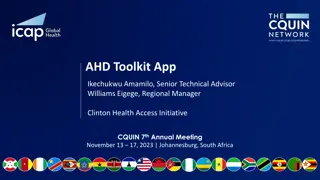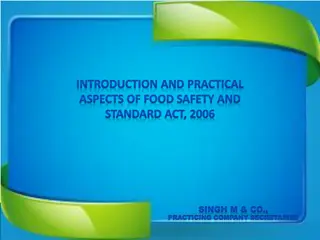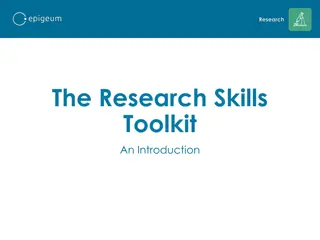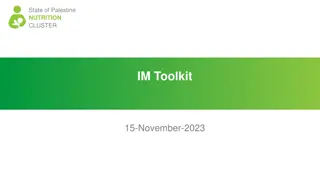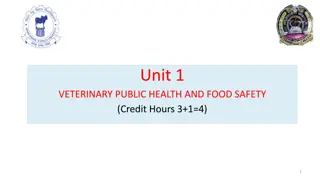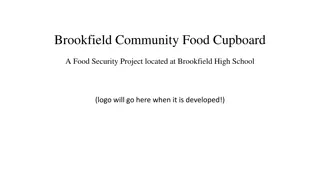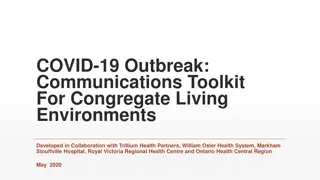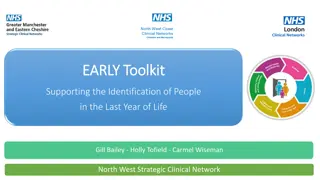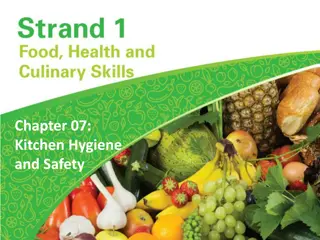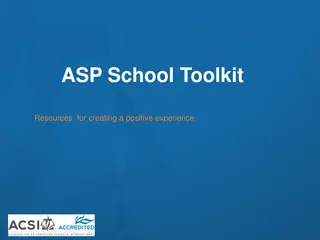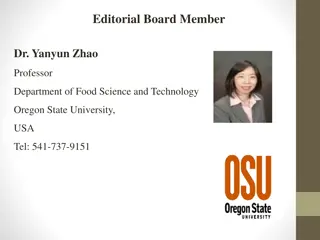Overview of CIFOR Toolkit Focus Area 2: Necessary Resources in Food Safety
Explore the presentation on CIFOR Toolkit Focus Area 2 by the New York Integrated Center of Food Safety Center of Excellence. Learn about utilizing the toolkit, necessary resources, upcoming sessions, and focus on emerging food safety issues. Discover how to prioritize recommendations for improving foodborne disease outbreak response in your jurisdiction.
Download Presentation

Please find below an Image/Link to download the presentation.
The content on the website is provided AS IS for your information and personal use only. It may not be sold, licensed, or shared on other websites without obtaining consent from the author.If you encounter any issues during the download, it is possible that the publisher has removed the file from their server.
You are allowed to download the files provided on this website for personal or commercial use, subject to the condition that they are used lawfully. All files are the property of their respective owners.
The content on the website is provided AS IS for your information and personal use only. It may not be sold, licensed, or shared on other websites without obtaining consent from the author.
E N D
Presentation Transcript
CIFOR Toolkit: An Overview of Focus Area 2 Necessary Resources New York Integrated Center of Food Safety Center of Excellence July 27, 2016 Paula Huth, MPH Bureau of Communicable Disease Control New York State Department of Health
2 Background This is the third webinar in a series of monthly webinars from the New York Integrated Center of Food Safety Center of Excellence (NYCoE) Session will cover CIFOR Toolkit Focus Area 2: Necessary Resources Upcoming monthly sessions will work through the entire CIFOR Toolkit, Focus Areas 3-11
3 Background Additional sessions will focus on emerging issues in food safety including culture independent diagnostic testing, antimicrobial resistance, and advanced molecular detection/whole genome sequencing All webinars will be recorded and available through the NYSDOH Learning Management System (LMS) at: www.nylearnsph.com Slide decks/recordings for all webinars will post to the NYCoE website: http://nyfoodsafety.cals.cornell.edu/training/cifor-webinar-series
4 Objectives Describe how to use the CIFOR Toolkit (Worksheets) Explain Focus Area 2: Necessary Resources Review Goals Review Keys to Success and Recommendations Outbreak Response Team Surge Capacity Making Changes Image: http://www.dalecarnegiewayindy.com/2012/07/06/three-keys-to-success-in-sales/
5 How to Use the CIFOR Toolkit For each Focus Area (1-11), complete the corresponding worksheet if the topic is deemed as a high priority regarding efforts to improve foodborne disease outbreak response in your agency/jurisdiction Complete the Worksheet as a Team (Workgroup) Epidemiology, Laboratory, Environmental Health and other agencies Describe your jurisdiction s current activities/procedures for the Focus Area Refer to written protocols/procedures and materials related to ongoing efforts in capacity development or quality improvement Indicate any activities that, if modified, could improve your jurisdiction s response to foodborne disease outbreaks
6 How to Use the CIFOR Toolkit Prioritize CIFOR Recommendations to Address Needed Improvements Based on needs identified in your jurisdiction, review the CIFOR recommendations related to the Focus Area of interest Rate the priority for implementing each recommendation based on its likely impact on foodborne outbreak response in your jurisdiction Some recommendations may already be in place at your agency, or not relevant to your agency, and can be marked as such Identify activities and procedures in need of improvement
7 Focus Area 2 Title: Necessary Resources Goal of the Focus Area: Agency/jurisdiction has ready access to personnel, supplies, equipment, documents, and references necessary to initiate a rapid and effective outbreak response
8 Toolkit Tracks and Focus Areas
9 Keys to Success Activities, relationships, and resources that are critical to achieving success in a Focus Area Outbreak Response Team Surge Capacity Making Changes Determining whether your jurisdiction has a particular key to success in place can be subjective; use your best judgement in deciding whether an activity is partially or fully in place Applying metrics and measures can help you identify the success of your program or investigation process
10 Outbreak Response Team 4 Keys to Success 1. Agency/jurisdiction has access to staff with knowledge and experience in epidemiology, environmental health, laboratory science, health education and communications to help in the response outbreak 2. Agency/jurisdiction has a designated outbreak response team with expertise in epidemiology, environmental health and laboratory science
11 Outbreak Response Team 3. Outbreak response team members have been trained in the agency s/jurisdiction s outbreak response protocols and their individual and combined roles 4. Staff have access to and familiarity with standard documents used in an outbreak response including reporting forms, questionnaires, and disease-specific information sheets
12 Outbreak Response Team Composition varies, but almost always need knowledge and skills pertaining to: Environmental Health Epidemiology Laboratory Public Health Education Communications Leadership
13 Outbreak Response Team Other skill sets often included on outbreak response team: Health Care Providers Regulatory Investigators Veterinarians Public Information Officer Industry Members Clerical Staff Interpreters
14 Recommendations: Outbreak Response Team Prior to outbreak: Determine outbreak response team composition Team expertise to include epidemiology, environmental health, laboratory science and risk communications Ensure that members of the team know each other Pre-assign specific tasks to members based on skill set Ensure that laws/legal authorities/MOUs needed to support response activities (surveillance, detection, investigation, control) are in place; and that team members understand how to apply them
15 Recommendations: Outbreak Response Team Prior to outbreak: Identify support personnel to assist team during outbreak response Keep dedicated equipment/supplies ready for use by the team (kits), and review supplies regularly to replace missing/expired materials Identify standardized outbreak-related forms and train team members how to properly/efficiently complete such forms and share information Obtain tools to analyze data and ensure staff are trained on use Assemble a reference library with information regarding foodborne/enteric disease, control measures, and subject matter experts
16 Recommendations: Outbreak Response Team Prior to outbreak: Determine storage capacity for lab samples collected during an outbreak Develop written guidance on sample collection and management Ensure that electronic records management procedures are in place Train team using agency s outbreak response protocol and exercise together to define roles/responsibilities and identify gaps in resources Conduct regional trainings with multiple agencies, including food industry Provide continuing education to team members to maintain/improve skills
17 Recommendations: Outbreak Response Team During outbreak response: Designate a team leader to set/enforce investigation priorities, coordinate activities, and communicate with decision-makers Ensure that all team members have a common understanding that the primary goal of response is to implement control measures as quickly as possible to prevent additional illness Have legal council available Recruit additional team members with other areas of expertise, as each unique outbreak warrants
18 Surge Capacity 2 Keys to Success 1. Available resources allow agency/jurisdiction to continue other necessary (core) functions during an outbreak response 2. Agency/jurisdiction anticipates gaps in resources and identifies sources to fill those gaps before an outbreak occurs Obtaining epidemiologic support from the state public health agency Identification of outside laboratories to provide testing support in large outbreaks
19 Recommendations: Surge Capacity Identify individuals who can conduct interviews/provide support to response team during large-scale outbreaks Develop a contact list for these staff, including after-hours Develop job descriptions for these staff Provide staff with training on outbreak response Involve non-foodborne disease staff in foodborne disease outbreak responses, periodically, to augment response resources when needed Develop processes for requesting help from other agencies in response to an outbreak, and ensure key staff know how/when to activate
20 Making Changes 2 Keys to Success 1. Agency/jurisdiction conducts a debriefing among investigators following each outbreak response and refines outbreak response planning based on lessons learned 2. Agency/jurisdiction has performance indicators related to the resources necessary for successful outbreak response and routinely evaluates its performance in this Focus Area
21 Recommendations: Making Changes Conduct debriefings after each outbreak among response team members to identify lessons learned Refine outbreak response preparation and planning activities based on lessons learned
22 Helpful Tips for Using the Toolkit Don t get distracted by the volume Be clear on the process Keep moving don t get caught up in too much detail Focus on a few realistic changes End with specific action plans Include time frames and responsible persons Appoint a facilitator and a recorder for each discussion
23 Why Should My State Use the Toolkit? 1. Improve foodborne outbreak investigation and response 2. Enhance partnerships with agencies/partners in foodborne outbreak investigations 3. Identify areas needing improvement that may have otherwise gone unrecognized
24 Where to Find the CIFOR Products Online at: www.cifor.us Paper copies are also available from CSTE Contact Dhara Shah at dshah@cste.org Examples of CIFOR product use by other states: http://www.coefoodsafetytools.org/
25 Next Scheduled NY CoE CIFOR Webinars Tuesday, August 23, 2016 @ 2-3 PM Focus Area 3: Communication Course announcement and link to register is posted on the NY CoE website, as well as, the DOH Learning Management System (LMS): www.nylearnsph.com
26 Resources Comments or questions for NY CoE can be directed to: Paula Huth, NY CoE Program Coordinator 518-473-4439 or paula.pennell-huth@health.ny.gov Integrated Food Safety CoE Websites: NY CoE: http://nyfoodsafety.cals.cornell.edu/ CDC: http://www.cdc.gov/foodsafety/centers/



